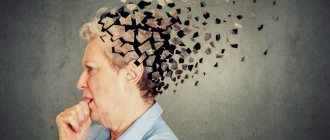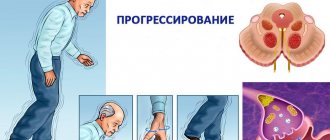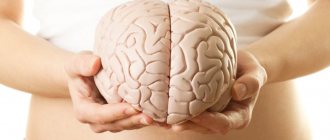Appointment with a psychiatrist at the psychiatric clinic sch.clinic +7
Dementia with Lewy bodies is characterized by chronic impairment of cognitive functions with the appearance of intracellular inclusions, called Lewy bodies, in the cytoplasm of neurons in the cerebral cortex.
Dementia in Parkinson's disease is a cognitive disorder characterized by the formation of Lewy bodies in the substantia nigra; it develops late in Parkinson's disease. Dementia is a chronic, usually irreversible, decline in cognitive function that affects all aspects of cognitive activity.
Dementia with Lewy bodies is the 3rd most common type of dementia. The onset of the disease usually occurs over 60 years of age.
Lewy bodies are spherical, eosinophilic, cytoplasmic neuronal inclusions composed of aggregates of the synaptic protein alpha-synuclein. They are found in the cerebral cortex of patients with primary dementia with Lewy bodies. With this disease, the levels of neurotransmitters change and neuronal connections between the striatum and neocortex are disrupted.
Lewy bodies are also found in the substantia nigra of patients with Parkinson's disease, and dementia (Parkinson's disease dementia) may, in some cases, develop later in the course of the disease. About 40% of patients with Parkinson's disease develop Parkinson's disease dementia; which is usually discovered at the age of 70, and 10-15 years after Parkinson's disease was diagnosed.
Because Lewy bodies are present in both dementia with Lewy bodies and dementia Parkinson's disease, some experts believe that both disorders may be part of a generalized synucleinopathy affecting both the central and peripheral nervous systems. Lewy bodies can also sometimes be detected in Alzheimer's disease, and in patients with dementia with Lewy bodies, the formation of neuritic plaques and neurofibrillary tangles is also observed in some cases. Thus, to some extent, Lewy body dementia, Parkinson's disease and Alzheimer's disease share common features. Further research is needed to clarify these relationships.
Both types of dementia - with Lewy bodies and dementia with Parkinson's disease - have a progressive course with a poor prognosis.
Dementia should not be confused with delirium, although cognitive function is impaired in both conditions. The following features usually help distinguish dementia from delirium:
- Dementia primarily affects memory, is usually caused by anatomical changes in the brain, has a slower onset and is usually irreversible.
- Delirium primarily affects attention, usually occurs during acute illness or as a result of toxic exposure (sometimes life-threatening), and is often reversible.
Other characteristic features also help differentiate dementia from delirium (see Differential Diagnosis of Delirium and Dementia*).
Clinical manifestations
Dementia with Lewy bodies
The initial decline in cognitive function in dementia with Lewy bodies resembles that in other dementias; it includes declines in memory, attention and executive function, as well as behavioral problems.
Extrapyramidal symptoms develop (usually including rigidity, bradykinesia, and gait instability) (see also Overview of Movement and Cerebellar Disorders). However, in Lewy body dementia (unlike Parkinson's disease), cognitive impairment and extrapyramidal symptoms develop in the first year of the disease. Also, extrapyramidal symptoms differ from those in Parkinson's disease; In dementia with Lewy bodies, tremor does not develop in the early stages of the disease; axial muscle rigidity and gait disturbances occur earlier, and symptoms have a symmetrical distribution. Repeated falls are common.
Fluctuation of cognitive function is a relatively specific symptom for dementia with Lewy bodies. Periods of the patient being active, with adequate behavior and orientation, may be followed by periods of confusion and lack of response to questions asked, which usually last for days or weeks, but then again give way to the ability to make contact.
Memory deteriorates, but the deterioration is manifested to a greater extent due to a lack of alertness and attention than memory itself; thus, short-term response is less affected than digit span memory (ability to repeat 7 digits forward and 5 backwards).
Patients may stare at one point for a long time. Excessive sleepiness during the day is common.
Visuospatial orientation and visuoconstructional ability (block tests, drawing a clock, or copying shapes) are more affected than other cognitive functions.
Visual hallucinations are a characteristic and often life-threatening manifestation of the disease, in contrast to benign hallucinations in Parkinson's disease. Auditory, olfactory, and tactile hallucinations are less common. In 50–65% of patients, delusions occur that are complex and bizarre in nature, which distinguishes it from simple delusions of persecution in Alzheimer's disease.
Autonomic disorders often develop with the occurrence of unexplained fainting conditions. Autonomic disturbances may occur simultaneously with the onset of cognitive deficits or shortly after their onset. Hypersensitivity to antipsychotics is typical.
Sleep disturbances are common. Many patients experience behavior disorder during rapid eye movement (REM) sleep, and parasomnia disorders are characterized by vivid dreams without the skeletal muscle relaxation typically seen in REM sleep. As a result, dreams may be accompanied by motor activity, which sometimes leads to injury to the bed partner.
Pick's disease: 3 stages
Pick's disease has three stages of development, which gradually transform into one another. It is extremely rare for a person with this disease to live more than ten years.
First stage of the disease
At the first stage, the character becomes selfish, unmotivated actions appear, which are explained by the sick person by the fact that it is impossible not to carry them out.
- Speech changes: speech slows down, there is repeated repetition of the same words, standard expressions and jokes.
- Self-criticism decreases.
- There is a slowdown, less often hyperkinesis of actions.
- There is a loss of former moral principles - instinctive emancipation: a person can relieve himself in public, for example. Sexual promiscuity is noted.
- Psycho-emotional changes occur occasionally: hallucinations, delusions of inferiority, jealousy.
Second stage
The transition of all symptoms to a focal form and progression occurs in the next stage of Pick's disease.
The following symptoms are more pronounced:
- State of amnesia.
- Agnosia is a violation of visual, auditory, and tactile functions.
- Aphasia is a speech pathology, when the speech reserve decreases, the patient loses the ability to express his thoughts. Understanding the speech of others also becomes difficult; the patient cannot grasp its meaning.
- Apraxia – the ability to perform actions is impaired or the sequence of execution changes. So, having received candy, a person can unwrap it, throw out the sweet itself, and put the candy wrapper in his mouth.
- Acalculia is a violation of the ability to perform computational operations, even the simplest.
Third stage
The third stage leads to irreversible profound dementia. The patient needs constant monitoring and psychological assistance.
Read material on the topic: Senile insanity: signs, treatment and patient care
Dementia in Parkinson's disease
In Parkinson's disease dementia (as opposed to Lewy body dementia), the cognitive impairment leading to dementia typically begins 10 to 15 years after the onset of uncontrolled motor symptoms.
Parkinson's disease dementia can affect several cognitive domains, including attention, memory, visuospatial orientation, and constructive and executive functions. Executive dysfunction tends to occur earlier and more frequently in Parkinson's disease dementia than in Alzheimer's disease.
Psychiatric symptoms (eg, hallucinations, delusions) are less frequent and/or less severe than in dementia with Lewy bodies.
In Parkinson's disease dementia, postural instability and gait abnormalities are more common, motor function declines more quickly, and falls are more common than in Parkinson's disease without dementia.
Is it about genes?
The cause of Parkinson's disease is unknown to doctors today. Most often, doctors tend to attribute it to a genetic failure. At the same time, it develops due to the absence or deficiency of the hormone dopamine: it acts as an intermediary between areas of the brain, due to which a person can perform basic and controlled movements. There are, however, a number of factors that can provoke the problem. These include:
- Head injuries accompanied by loss of consciousness;
- Presence of migraines with aura;
- Living in industrial areas with high levels of air pollution;
- Contact with pesticides during agricultural work;
- Constant consumption of large amounts of milk;
- Excess body weight.
Of course, these factors do not directly cause Parkinson's disease. However, they can have a direct impact on the development of pathology in the future.
As for Alzheimer's disease, it is also often attributed to a genetic predisposition. In addition, provoking factors include a deficiency of substances necessary for the transmission of nerve impulses, toxic metal poisoning, head injuries, brain tumors and thyroid disorders.
Everything's under control. What examinations should elderly people not skip?
More details
Diagnostics
- Clinical criteria
- Neuroimaging to exclude other diseases
The diagnosis is made clinically, but the sensitivity and specificity of this approach are low.
- To make a general diagnosis of dementia, all of the following criteria must be present:
- Cognitive or behavioral (neuropsychiatric) symptoms affect the ability to function at work or perform normal daily activities.
- These symptoms represent a clear decline from previous levels of functioning.
- These symptoms are not explained by the presence of delirium or a major mental disorder.
The assessment of cognitive impairment includes a history from both the patient and his acquaintances, plus a so-called bedside mental status examination or, if the results are equivocal, formal neuropsychological tests.
A diagnosis of dementia with Lewy bodies is considered probable if 2 of the following 3 features are present, and considered probable if 1 feature is present:
- Cognitive instability
- Visual hallucinations
- Parkinsonism
Criteria confirming the diagnosis include recurrent falls, syncope, disturbances in the paradoxical stage of sleep, and increased sensitivity to antipsychotics.
The overlap between symptoms of Lewy body dementia and Parkinson's disease dementia can make diagnosis difficult:
- When motor impairment (eg, tremor, bradykinesia, and muscle rigidity) precedes and is more severe than cognitive impairment, a diagnosis of Parkinson's disease dementia is usually made.
- If early cognitive impairment (in particular, executive dysfunction) and behavioral changes predominate, a diagnosis of dementia with Lewy bodies is made.
Because patients with Lewy body dementia often have attention deficits that are more common in delirium than in dementia, delirium should be assessed for delirium, particularly for common causes such as
- Taking medications (especially anticholinergic drugs, psychotropic and opioid drugs)
- Dehydration
- Infection
CT and MRI do not reveal any specific changes, but these studies are necessary to exclude other causes of dementia. Fluorine-18 (18F)-labeled deoxyglucose (fluorodeoxyglucose, or FDG) PET and 123I-FP-CIT (N-3-fluoropropyl-2β-carbomethoxy-3β-[4-iodophenyl]-tropane) single photon emission CT (SPECT) ), a fluoroalkyl analogue of cocaine, can help diagnose dementia with Lewy bodies, but are not common testing methods.
The final diagnosis requires examination of the brain substance at autopsy.
Similarities of diseases
- Both belong to the group of neurodegenerative pathologies. This means that they develop due to the destruction of brain cells (neurons). These destructions are irreversible, and they will continue until the end of life.
- There are common provoking factors for the development of diseases, for example, old age, a history of traumatic brain injuries, heart and vascular diseases (hypertension, heart attacks), unfavorable ecology, and hereditary predisposition.
- Both are common among older people, but can also occur among younger people.
- There is no medicine that can cure both. But there are ways to slow the progression.
Basic provisions
- Because Lewy bodies appear in Lewy body dementia and Parkinson's disease, some experts suggest that both disorders are part of the same synucleinopathy that affects the central and peripheral nervous systems.
- Dementia with Lewy bodies should be suspected if dementia develops almost simultaneously with parkinsonism, and in cases where dementia is accompanied by fluctuations in cognitive function, loss of attention, the presence of psychiatric symptoms (eg, visual hallucinations; complex, bizarre delusions), and autonomic dysfunction .
- Dementia in Parkinson's disease should be suspected if dementia begins several years after the onset of parkinsonism, particularly if there is an earlier onset of executive dysfunction.
Authors: Juebin Huang, MD, PhD, Memory Impairment and Neurodegenerative Dementia (MIND) Center, University of Mississippi Medical Center Last full review/revision March 2021 by Juebin Huang, MD, PhD
Treatment
Unfortunately, there is currently no effective therapy for Pick's disease. The main task of the doctor after diagnosing this disease is to support the patient’s body and slow down the destructive processes in the brain. Accordingly, treatment is selected based on the stage of the pathology and the presence of certain symptoms. It can be:
- antidepressants;
- MFO inhibitors;
- neuroprotectors to stimulate metabolic processes in the brain and increase cell activity, which helps slow down atrophic processes;
- sometimes anti-inflammatory therapy is needed;
- sedatives stabilize the psycho-emotional background and reduce aggressiveness.
One of the stages of helping a patient is constant care in the final stages. When a patient loses self-care skills, not only is he unable to perform most common household tasks, but he may also cause harm to himself or others. The solution to this problem is professional nursing care if relatives cannot be with the patient around the clock.
There is also no specific prevention for Pick's disease. General recommendations relate to maintaining a healthy lifestyle, promptly consulting a doctor if you suspect brain pathologies, and taking activities that improve cognitive function. People who have relatives with a similar disease or other types of dementia should be especially careful.
The prognosis for Pick's disease is poor. The duration of the disease until the patient’s death is influenced by age, general health, and the adequacy of the prescribed therapy.










